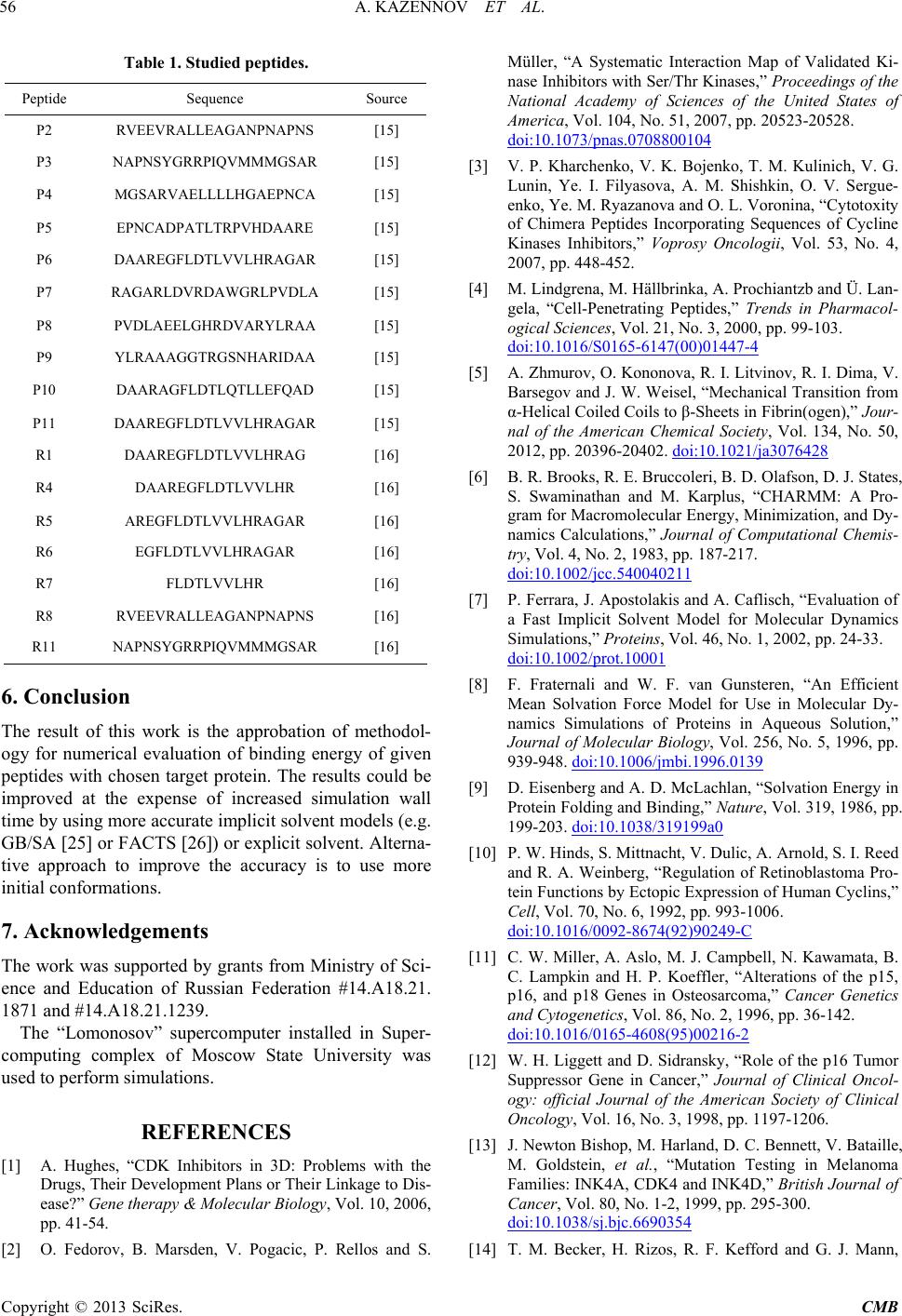
A. KAZENNOV ET AL.
56
Table 1. Studied peptides.
Peptide Sequence Source
P2 RVEEVRALLEAGANPNAPNS [15]
P3 NAPNSYGRRPIQVMMMGSAR [15]
P4 MGSARVAELLLLHGAEPNCA [15]
P5 EPNCADPATLTRPVHDAARE [15]
P6 DAAREGFLDTLVVLHRAGAR [15]
P7 RAGARLDVRDAWGRLPVDLA [15]
P8 PVDLAEELGHRDVARYLRAA [15]
P9 YLRAAAGGTRGSNHARIDAA [15]
P10 DAARAGFLDTLQTLLEFQAD [15]
P11 DAAREGFLDTLVVLHRAGAR [15]
R1 DAAREGFLDTLVVLHRAG [16]
R4 DAAREGFLDTLVVLHR [16]
R5 AREGFLDTLVVLHRAGAR [16]
R6 EGFLDTLVVLHRAGAR [16]
R7 FLDTLVVLHR [16]
R8 RVEEVRALLEAGANPNAPNS [16]
R11 NAPNSYGRRPIQVMMMGSAR [16]
6. Conclusion
The result of this work is the approbation of methodol-
ogy for numerical evaluation of binding energy of given
peptides with chosen target protein. The results could be
improved at the expense of increased simulation wall
time by using more accurate implicit solvent models (e.g.
GB/SA [25] or FACTS [26]) or explicit solvent. Alterna-
tive approach to improve the accuracy is to use more
initial conformations.
7. Acknowledgements
The work was supported by grants from Ministry of Sci-
ence and Education of Russian Federation #14.A18.21.
1871 and #14.A18.21.1239.
The “Lomonosov” supercomputer installed in Super-
computing complex of Moscow State University was
used to perform simulations.
REFERENCES
[1] A. Hughes, “CDK Inhibitors in 3D: Problems with the
Drugs, Their Development Plans or Their Linkage to Dis-
ease?” Gene therapy & Molecular Biology, Vol. 10, 2006,
pp. 41-54.
[2] O. Fedorov, B. Marsden, V. Pogacic, P. Rellos and S.
Müller, “A Systematic Interaction Map of Validated Ki-
nase Inhibitors with Ser/Thr Kinases,” Proceedings of the
National Academy of Sciences of the United States of
America, Vol. 104, No. 51, 2007, pp. 20523-20528.
doi:10.1073/pnas.0708800104
[3] V. P. Kharchenko, V. K. Bojenko, T. M. Kulinich, V. G.
Lunin, Ye. I. Filyasova, A. M. Shishkin, O. V. Sergue-
enko, Ye. M. Ryazanova and O. L. Voronina, “Cytotoxity
of Chimera Peptides Incorporating Sequences of Cycline
Kinases Inhibitors,” Voprosy Oncologii, Vol. 53, No. 4,
2007, pp. 448-452.
[4] M. Lindgrena, M. Hällbrinka, A. Prochiantzb and Ü. Lan-
gela, “Cell-Penetrating Peptides,” Trends in Pharmacol-
ogical Sciences, Vol. 21, No. 3, 2000, pp. 99-103.
doi:10.1016/S0165-6147(00)01447-4
[5] A. Zhmurov, O. Kononova, R. I. Litvinov, R. I. Dima, V.
Barsegov and J. W. Weisel, “Mechanical Transition from
α-Helical Coiled Coils to β-Sheets in Fibrin(ogen),” Jour-
nal of the American Chemical Society, Vol. 134, No. 50,
2012, pp. 20396-20402. doi:10.1021/ja3076428
[6] B. R. Brooks, R. E. Bruccoleri, B. D. Olafson, D. J. States,
S. Swaminathan and M. Karplus, “CHARMM: A Pro-
gram for Macromolecular Energy, Minimization, and Dy-
namics Calculations,” Journal of Computational Chemis-
try, Vol. 4, No. 2, 1983, pp. 187-217.
doi:10.1002/jcc.540040211
[7] P. Ferrara, J. Apostolakis and A. Caflisch, “Evaluation of
a Fast Implicit Solvent Model for Molecular Dynamics
Simulations,” Proteins, Vol. 46, No. 1, 2002, pp. 24-33.
doi:10.1002/prot.10001
[8] F. Fraternali and W. F. van Gunsteren, “An Efficient
Mean Solvation Force Model for Use in Molecular Dy-
namics Simulations of Proteins in Aqueous Solution,”
Journal of Molecular Biology, Vol. 256, No. 5, 1996, pp.
939-948. doi:10.1006/jmbi.1996.0139
[9] D. Eisenberg and A. D. McLachlan, “Solvation Energy in
Protein Folding and Binding,” Nature, Vol. 319, 1986, pp.
199-203. doi:10.1038/319199a0
[10] P. W. Hinds, S. Mittnacht, V. Dulic, A. Arnold, S. I. Reed
and R. A. Weinberg, “Regulation of Retinoblastoma Pro-
tein Functions by Ectopic Expression of Human Cyclins,”
Cell, Vol. 70, No. 6, 1992, pp. 993-1006.
doi:10.1016/0092-8674(92)90249-C
[11] C. W. Miller, A. Aslo, M. J. Campbell, N. Kawamata, B.
C. Lampkin and H. P. Koeffler, “Alterations of the p15,
p16, and p18 Genes in Osteosarcoma,” Cancer Genetics
and Cytogenetics, Vol. 86, No. 2, 1996, pp. 36-142.
doi:10.1016/0165-4608(95)00216-2
[12] W. H. Liggett and D. Sidransky, “Role of the p16 Tumor
Suppressor Gene in Cancer,” Journal of Clinical Oncol-
ogy: official Journal of the American Society of Clinical
Oncology, Vol. 16, No. 3, 1998, pp. 1197-1206.
[13] J. Newton Bishop, M. Harland, D. С. Bennett, V. Bataille,
M. Goldstein, et al., “Mutation Testing in Melanoma
Families: INK4A, CDK4 and INK4D,” British Journal of
Cancer, Vol. 80, No. 1-2, 1999, pp. 295-300.
doi:10.1038/sj.bjc.6690354
[14] T. M. Becker, H. Rizos, R. F. Kefford and G. J. Mann,
Copyright © 2013 SciRes. CMB